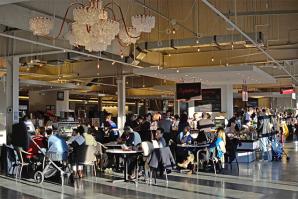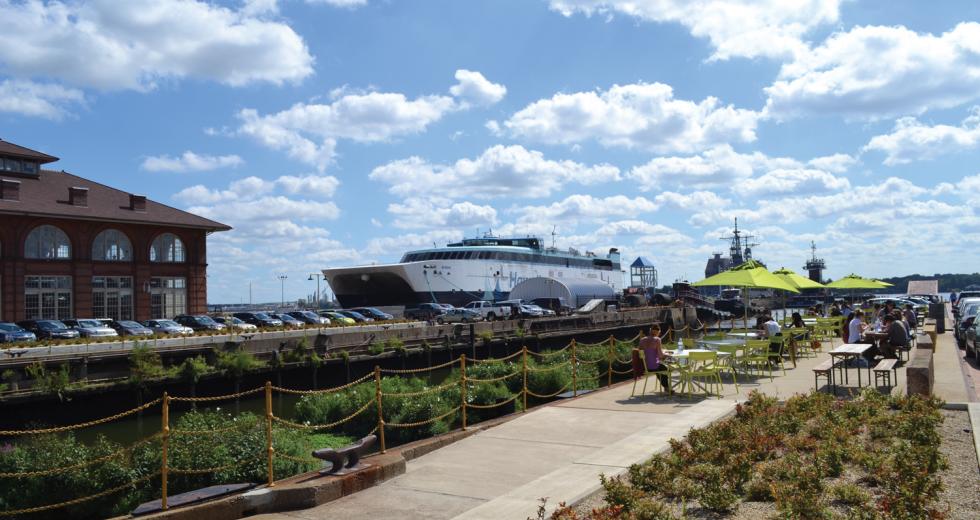Like Sacramento’s railyards, Philadelphia’s Navy Yard was once a shuttered property with problems and potential. Today, it’s a thriving 1,200-acre business campus with 130 companies occupying more than 6.5 million square feet of office, industrial, manufacturing, and research and development space.
You may have recently noticed some random references to JFDI. Maybe it was in a tweet or a sticker on the back of a cell phone. The initials stand for Just F*cking Do It.
It isn’t a new movement or an acronym from a New York Times Best Seller. It represents an attitude, a mindset and — most importantly — an unwavering willingness to act. It was perhaps my greatest takeaway from this year’s Sacramento Metro Chamber Study Mission to Philadelphia.
Study Mission is an opportunity for the region’s thought leaders to engage, explore and identify best practices in another city and bring these catalytic ideas back to our region. In September, I was one of 76 business, civic and philanthropic leaders who took this field trip to Philadelphia in an effort to engage, explore and identify best practices in another city and bring these catalytic ideas back home.
The selection of Philadelphia was led by two of Sacramento’s most dynamic women: Study Mission Chair Christine Ault and Drexel Associate Vice Provost and Metro Chamber board member Sandra Kirschenmann. Initially, there was apprehension about going to the city of brotherly love, but Philadelphia’s similarities to Sacramento were quickly made apparent.
Philly ranks fourth in the eastern seaboard’s popularity contest, behind its neighbors New York, Boston and Washington. Likewise, Sacramento struggles in the shadow of San Francisco, San Jose and L.A. Philly’s Navy Yards, like our railyards, were underused and barren. It has struggled with identity, as locals and visitors alike recognize it more as the home of Rocky Balboa than its current distinction in “eds and meds.”
During our four days in the city, we did everything from touring Urban Outfitters’ edgy global headquarters to gleaning compelling insights on economic financing. But it may have been a walking tour with a few local “nerds” that created the biggest impact.
North 3rd Street is a collection of coworking spaces and tech startups that are redefining Philadelphia’s economy, workforce and culture. Ironically, these innovators, inventors and idealists (which affectionately refer to their neighborhood as N3RD Street) are no different than a group of business leaders that collaborated on Philadelphia streets and in its pubs nearly 230 years ago — our Founding Fathers. They are all agitators; a pebble in the shoe of status quo.
It was one of these agitators that shared with us JFDI. Alex Hillman, describes himself as “the fearless leader of Indy Hall (a coworking space).” Fearless is probably a mild way of putting it. His philosophy and beliefs are not for everyone, but in that moment, we knew a dose of Alex was just what Sacramento needed.
One conversation begot the next, and quickly a theme developed. Every person we spoke to in Philadelphia talked about a catalyst event that led to collaboration that led to a plan that led to action.
Did you catch that last phase? Action.
When Philadelphia was near bankruptcy, it created a strategic plan for economic development. Philadelphia’s Economic Development Corp., a joint venture of the city of Philadelphia and Greater Philadelphia Chamber of Commerce, has been the core driver of this plan. The result: more than $19 billion in project investments and the retention of more than 400,000 jobs. And, in only 10 short years, the The Navy Yard has been filled with fresh businesses, 70 percent of which are new to Philadelphia.
When Philly realized it was losing millennials to cities like Boston, it focused on creating a sense of place and student activities off campus. The fruits of their labor are seen in the vibrant downtown dining and bar districts and civic amenity investments. The result: a 45 percent increase in college graduate retention and placement on the list of Top 10 Happiest Cities for Young Professionals.
After losing an Olympic bid, Philadelphia leaders and its convention and visitors bureau discovered the city didn’t lose because of lack of hotels or infrastructure, but because of a lack of identity. Sound familiar? The result: a PHL brand that is “embraced by all and owned by none.” We saw it everywhere we went, from the lapel pin of the mayor to storefront windows.
In Sacramento, we know how to plan. We talk and brainstorm and plan very well. The Sacramento Riverfront Master Plan calls for a pedestrian bridge between Sacramento and West Sacramento that is far from breaking ground. The Railyard Master Plan has sat idle for years. We have a game-changing Entertainment and Sports Facility Plan right in front of us, yet we’re confronted with naysayers and critics. Our propensity toward collaboration and planning has given us a monumental platform for regionwide economic development in Next Economy, endorsed by 24 of the region’s 29 jurisdictions, yet the plan’s action items lack unanimous support.
I’m tired of talking. I’m tired of individuals and organizations waiting for an invitation to act or looking to others to do the work. And I’m not the only one. It is now a time for action and attitude. It is time to create a swagger for this city, a confidence in our actions as much as our words.
How can I, how can all of us, get it done? We can start by supporting, celebrating and joining those that do. The Gina Lujans who have done more in the past 60 days to bring fiber optics and startups to downtown than nearly anyone has in years. The Chris Johnsons and Warren Smiths who believe in an idea — as small as ramen bowl or as big as con MLS soccer club — and make it come to life. Or the small-business owners that risk everything to pursue a passion. Sacramento has soul thanks to Old Soul, Temple, Ginger Elizabeth, Chocolate Fish, Track 7, New Helvetia and Ruhstaller, to name a few.
If you think action comes in leadership, then run. Run for office. The next few years will see seats open in organizations ranging from city council to the Board of Plumbing Examiners. A listing of open seats is available at cityofsacramento.org.
Think you are too young to run for office? Steve Hansen was 32 when he announced a run for Sacramento City Council. Christopher Cabaldon became West Sacramento’s poster child for JFDI when he won his first mayoral election at 33. And when you win, commit to implementing the bigger vision as well as courageously calling out those that stand in the way.
Need a baby step? Write JFDI on a Post It. Look at it every day. Make it a part of who you are. Hashtag #JFDISac in your tweets.
Planning and collaboration are an important piece to success, but not always the first steps, and most importantly, not the only steps. Vivek Ranadivé didn’t spend years creating a plan to become the owner of the Sacramento Kings. What he did do was pick up the phone, call Mayor Johnson and set actions in place that culminated in the Kings remaining in this indomitable city.
We also need to pay attention to what we are doing. Numerous Sacramentans, passionate about our food and agriculture, are the catalyst for our designation as Farm-to-Fork Capital of America. It’s the Joanne Nefts, Josh Nelsons, Patrick Mulvaneys and groups such as Soil Born Farms and Center for Land Based Learning that are leading by their actions.
The point is, let’s just f*cking do it. It is the only way Sacramento can be the world-class city we all want to be — and the 21st century city we deserve to be. #JFDISac
Recommended For You

Sacramento Needs a Public Market
The Farm-to-Fork Capital is incomplete without one
Great food capitals of the world: Can you name them? Florence. Paris. Tokyo. Barcelona. Istanbul. Singapore. What do these destinations of culinary delights offer?




